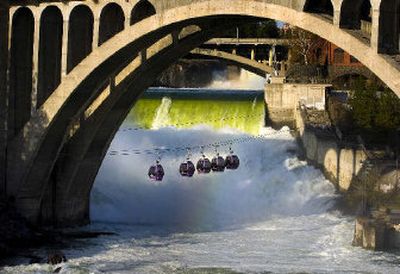Show must go on … and on

John Yelle and his wife, Neila, missionaries from Brazil, spent part of their afternoon Tuesday visiting the roaring Spokane Falls, swollen from the early stages of what promises to be a prolonged spring runoff.
“It’s impressive,” said Yelle after crossing a footbridge above the upper falls in Riverfront Park.
The couple said that a passage in the Bible compares the voice of God to the fury of the crashing water. “It definitely shows the power and majesty of God’s creation,” Yelle said.
Cool nights and dry weather in recent days have allowed the river to subside from near flood levels in mid-April, and snowpack in the mountains of northeast Washington and North Idaho is just beginning to “ripen” and run off, a hydrology expert said Tuesday.
Charles Ross of the National Weather Service in Spokane said he expects several more weeks of high flows on not only the Spokane River, but also all of the rivers in Eastern Washington and North Idaho. The Snake River is expected to be high in coming weeks because of heavy rain in southern Idaho and eastern Oregon.
While there is some risk of flooding, Ross said, forecasts show a greater likelihood that this year’s snowpack will drain out of the mountains without causing major problems, and that will allow an extended season for viewing the crashing water in the heart of Spokane.
“The weather is conducive to being a real orderly snow melt,” Ross said.
Forecasters on Tuesday said they expect several days of June-like weather starting on Thursday and extending into Sunday with temperatures on Friday and Saturday likely to hit the mid-70s in most locations in the region.
“It’s going to be a pretty awesome weekend for outdoor activities,” although with water temperatures in the 40s, people should stay out of the river, Ross said.
Medium-range computer forecasts show a return to seasonable temperatures starting Monday.
The Spokane River on Tuesday was flowing at an estimated 18,000 cubic feet per second, or about 3 feet below flood stage and an average flow for the spring runoff period.
“It’s going to last for the foreseeable future in some form,” Ross said, so there is no rush to make the trip to view the falls.
Lookout Pass along Interstate 90 on the Idaho-Montana state line still had 60 inches of compacted snow with a water content of 26 inches, Ross said. The automated snow reporting site is located at an elevation of 5,140 feet.
At Quartz Mountain near Mount Spokane, another automated site at 4,700 feet showed 54 inches of snow with 23 inches of water.
The level of Lake Coeur d’Alene was reported at 2,128 feet on Tuesday, or about a half foot above the expected summer level. Inflow from the St. Joe and Coeur d’Alene rivers had slowed from higher levels more than a week ago.